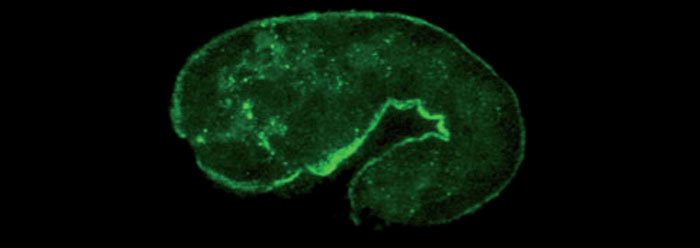For many creatures, embryonic development involves the amazing unfolding of a single cell into an animal with billions of cells, each with a specific structure and function. How does a small ball of identical dividing cells know when to start or stop its growth, as well as when or where (not to mention how) to begin differentiating into various types of tissues?
Scientists have believed that these critically timed triggers are programmed into the DNA, but a recent study of epithelial cells in certain roundworms showed that this assumption, though valid in most cases, does not explain everything.
Of the four main tissue types—which also include muscle, nervous, and connective—epithelial tissue consists of pancake-shaped cells that form the outer and inner linings of many organs such as the stomach, as well as the outer lining of the whole organism. During embryonic development, what triggers a stem cell to differentiate into an epithelial cell?
In a study published in the journal Nature, analyses were performed on the tiny Caenorhabditis elegans roundworm, which has been the subject of countless biological investigations. Researchers stimulated muscle contractions in worm embryos by attaching and manipulating a tiny needle, and found that the contraction of nearby muscle cells triggered epithelial cell development. They wrote, "Contractile forces seem to act like yin and yang in development: too much force will tear a tissue apart, but moderate and sustained force will promote differentiation."1
This discovery has profound implications for the roundworm and, by extension, for any other animal that relies on embryonic muscle contraction for proper development. First, the fact that specific elements other than DNA—in this case, nearby cells and their contractile motions—are required for proper development removes evolution from contention as a possible origins hypothesis, since evolution supposedly operates by making changes to DNA.2 So if something other than DNA is needed to develop and sustain life forms, then evolution is out.
Second, the specifications required for proper skin development are so precise and numerous that an ingenious Designer is required to explain them. For example, the muscle contractions are specified to a certain force for a certain length of time.
Also, the nearby cells must be equipped with a cellular structure called a "hemidesmosome," a button of sorts that anchors epithelial cells together. But this study found that the "hemidesmosome is not only an attachment structure, but also a mechanosensor that responds to tension by triggering signalling [sic] processes."1
In other words, this structure senses the nearby muscle contractions and converts those mechanical signals into chemical messengers. These chemicals in turn communicate to the cell that it is time to differentiate into epithelial tissue.
So, what does it take to make epithelial tissue in roundworms, and possibly in other creatures? The answer is: precisely the right DNA, the right hemidesmosomes, the right kinds of nearby muscle cells, and the right strength and duration of muscle contractions. Without all these features already in place and fine-tuned to work together, there would be no epithelial tissue, and as a result, no surviving creature.
Skin development could not have evolved by a gradual addition of traits, because this would require a version of the animal that did not already have all the required traits. Such a transitional form would have died, and the animal would not exist today. And since it certainly exists, it must have been created.
References
- Zhang, H. et al. 2011. A tension-induced mechanotransduction pathway promotes epithelial morphogenesis. Nature. 471 (7336): 99-103.
- Similarly, proper ear development requires not only DNA, but ciliary motion. See Thomas, B. The Delicate Balance of Ear Crystals. ICR News. Posted on icr.org December 9, 2008, accessed May 24, 2011.
Image credit: Copyright © 2011 Nature Publishing Group, a division of Macmillan Publishers Limited. Adapted for use in accordance with federal copyright (fair use doctrine) law. Usage by ICR does not imply endorsement of copyright holders.
* Mr. Thomas is Science Writer at the Institute for Creation Research.
